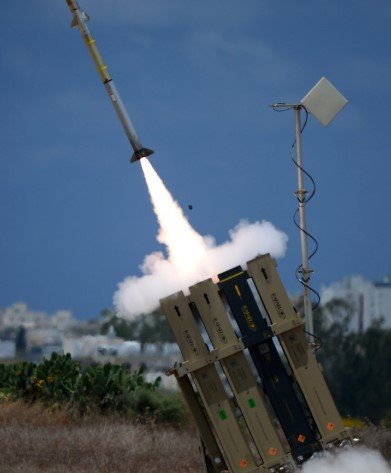Sirens blared across Jerusalem and much of central Israel in the early hours of Thursday after Israeli defense systems intercepted a missile launched from Yemen. There were no reported injuries, but the sense of unease was unmistakable.
It was the first time in months that the Houthis’ long-range capabilities reached deep into Israel’s heartland, reigniting concerns about Iran-backed threats that extend well beyond Gaza and Lebanon.
No Casualties, But the Message Landed Loud and Clear
The missile, launched shortly after 5:00 a.m., was picked up by Israeli detection systems while still en route. Within seconds, Iron Dome and Arrow batteries went into action. A single loud boom was heard in parts of Tel Aviv and Jerusalem. It was the sound of interception.
No injuries were reported, and no damage was caused, according to Magen David Adom, Israel’s national emergency medical service.
Still, that didn’t stop widespread panic from gripping early morning commuters and families still in bed. Social media feeds flooded with videos of red alert sirens and families scrambling into stairwells.
Just one sentence here to breathe.
This wasn’t just another rocket from Gaza. It was a longer-range threat, possibly cruise or ballistic, fired from over 1,500 kilometers away — and that’s why it hit differently.
IDF Confirms Interception, Eyes Yemen’s Houthi Militia
The Israeli military confirmed the missile came from Yemen, echoing the same launch trajectory and signatures seen in past Houthi attacks.
In recent days, Houthi militants — backed by Iran and operating out of northern Yemen — have stepped up activity, especially after resuming attacks in the Red Sea. The IDF’s early assessment points directly to them.

“We identified the missile shortly after launch. Interception was successful, and no further threat remains,” said an IDF spokesperson in a short morning briefing.
This follows the Houthis’ deadly double-strike earlier this week on the cargo vessel Eternity C, which was targeted on two consecutive days and eventually sank. Four people were killed.
A short sentence again, just for the pause.
That ship, the Houthis claimed, was headed for Eilat — Israel’s southern port city, referred to by the group using its pre-1948 Arabic name, Umm al-Rashrash.
Growing Red Sea Tensions and the Houthi Return
The missile launch is the latest indicator that the Houthis are back in action after several weeks of relative calm.
Their assault on commercial shipping has escalated:
-
Eternity C, a Liberia-flagged cargo ship, was hit twice in 48 hours, killing crew and prompting maritime insurers to raise premiums.
-
Houthi military spokesman Yahya Saree accused the ship’s owners of “resuming operations with the port of Umm al-Rashrash, in violation of the ban,” effectively issuing a warning to all foreign companies dealing with Israel.
Here’s where things get more troubling: Israeli defense officials believe the Houthis are not acting alone. There’s mounting evidence of logistical and possibly targeting assistance from Iran’s Quds Force. While Tehran continues to deny direct involvement, Israel isn’t buying it.
How Did a Missile From Yemen Reach Central Israel?
This is the technical part that security analysts are still debating. For a projectile to fly from Yemen and reach Jerusalem or Tel Aviv, it has to be long-range, possibly a cruise missile or medium-range ballistic missile.
Here’s a quick snapshot of the likely possibilities:
| Weapon Type | Estimated Range | Interception Difficulty | Origin Likely |
|---|---|---|---|
| Quds-2 Cruise Missile | ~1,400 km | Moderate | Houthi/Iran |
| Zulfiqar Ballistic | ~1,500 km | High | Iranian Supplied |
| Sa’ir-1 UAV (explosive drone) | ~1,200 km | Moderate | Yemen-based |
While Israeli defenses are advanced, intercepting a missile across that distance — and so deep into civilian territory — shows just how serious the threat has become. One intelligence officer speaking off the record said, “They’re probing. They want to know how far they can go.”
Political Ripples and Civilian Reaction
Inside the Knesset, lawmakers held an urgent security briefing by mid-morning. Right-wing politicians demanded immediate retaliation, while centrist voices called for restraint — at least until a full intelligence report is in.
There was no government announcement of a counterstrike as of Thursday evening, though drones and air assets have been moved south.
Among civilians, reactions ranged from frustration to fatigue. For many Israelis, missile alerts are nothing new. But the sheer distance this one traveled made it feel more unnerving.
“It’s one thing to hear rockets from Gaza. But Yemen? That’s a whole other kind of fear,” said Adi S., a Tel Aviv resident who heard the interception and raced with her kids into a stairwell.
Short pause again.
In Jerusalem, security presence was visibly beefed up, especially near the Knesset and government buildings.
What Comes Next? Israeli Security Officials on Edge
Thursday’s missile interception is unlikely to be the end of it. Intelligence officials expect more provocations. The Houthis may feel emboldened by what they see as a lack of international response to attacks on shipping and now missile launches.
The IDF is reviewing missile trajectories and radar patterns to determine the exact type and origin of the weapon. If confirmed to be Iranian-supplied, the next few days could see retaliation — not just in Yemen but possibly in Syria or Iraq, where Iranian proxies are active.
Another one-liner, just to keep it human.
Diplomatic efforts are also in motion. The U.S. is reportedly pressuring Gulf states to help clamp down on weapons routes into Yemen. The EU issued a brief statement condemning the attack and reiterating calls for de-escalation.
But the truth is, no one’s sure if this is a one-off — or the beginning of a longer campaign.
